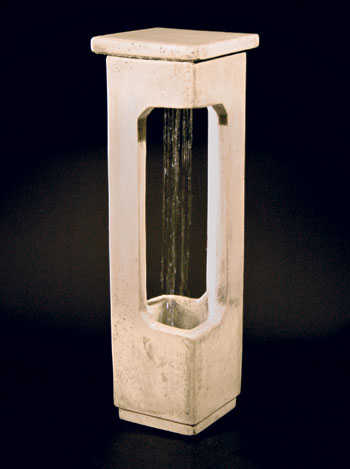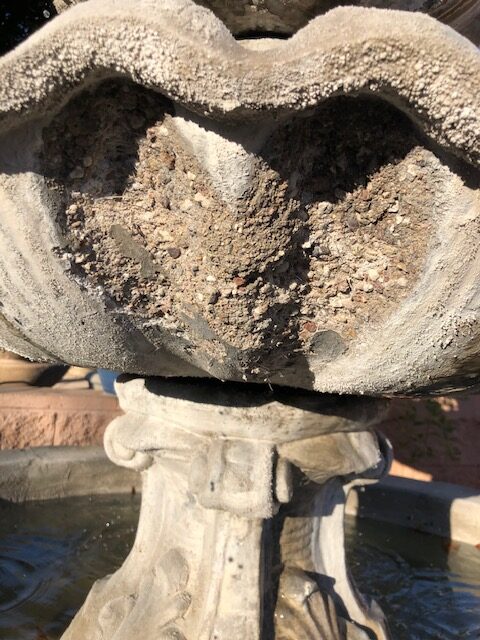Frequently Asked Questions!
- White stuff is forming on my fountain, what can I do about it?
- That’s going to be calcium! Here in Arizona, our water is hard and full of minerals. When the water in your fountain evaporates, it leaves all these minerals behind which cause the white spots to form.
- We offer additives that help to prevent and remove mineral stains, as well as a water filter that attaches to the hose to filter some of the minerals. Some light scrubbing with a soft brush may rid your fountain of the top layer, but it is almost impossible to return the fountain to “New” condition.
- As tempting as it may be, do not use harsh chemicals such as Lime-A-Way or CLR. These will remove the finish/ stain of your fountain.
-
Why is my water turning green?
- That would be algae. Algae will develop in water if left untreated, particularly in the warmer months. We carry various solutions to controlling algae, both liquids and solid cubes. All are safe for birds, plants and animals in their diluted form. Some are also safe for fish. We do not recommend bleach or most pool chemicals as the may shorten the life of the pump.
-
Why does my fountain smell funky?
- Your fountain most likely needs a bath! Although not often, fountains do need a cleaning here and there. We recommend turning the fountain off, draining the water, and scrubbing or removing all debris.
-
Why is my fountain making strange noises?
- This is most likely due to your pump! Sometimes pumps can be placed or can move into a position where they shouldn’t be. This can cause unwanted vibrating, air bubbles, amongst other problems. Sometimes in these positions, your pump may just lack water. This can cause problems by making your pump “run dry”. We recommend water exceeds your pump’s height by about 2 inches at least for best results.
-
Can I leave my fountain running all day?
- You sure can! Fountains recycle the water over and over, so as long as they don’t run dry, you should be fine! If you plan on leaving home for an extended period of time we recommend unplugging it to avoid having the pump run dry.
- Caution! If the weather is windy, even with a float system, the water can be blown out. If you leave, even to go to the store real quick on a a windy day you may return to a dry fountain. We suggest turning it off/unplugging it when you aren’t home on these days.
-
Why am I losing water?
Fountains are going to have different amounts of water-loss. Reasons may include:
-
-
- Evaporation –Most fountains in sunlight will lose water throughout the day, especially during the warmer months.
- Splashing –Especially with larger fountains there may be some splash, and with time, it adds up to more than one would think!
- Wildlife –Many times birds and even some four-legged friends will drink from fountains, and as long as we use SAFE products such as ours, this is fine!
- Rubber Grommet – Sometimes when installing fountains, the grommet can be placed improperly quite easily which may cause unwanted water loss. This can be fixed by readjusting and placing new plumber’s putty atop of the grommet.
-
-
What size pump works for my Fountain?
- Many pumps are represented by the Gallons Per Hour (GPH) measurement, this represents the strength of the suction/expel capabilities. For fountains however, this is not the only measurement you need. Fountains usually require a height measurement that the water must travel in order to reach the top for flow. THIS is what you need to know! From the pump location to the top, how many inches does it measure?
For example:
Consider the Rain fountain (pictured below). This fountain only holds about 10-15 gallons of water but it requires a 130 GPH pump to send the water up 40″. So a smaller pump, per the amount of gallons only, would not work for this fountain.

Will running my fountain during winter save it from the affects of freezing?
While the water as a majority may not freeze, the water within the pores of the fountain are what cause damage. The water penetrates the pores and when frozen expands, causing fractures along the way. Then, when it thaws out, the particles that have been expanded will fall or crumble, aka scaling or spalling. Early signs of damage will show on the outside of the bowl resembling the white of hard water stains.
Scaling is preventable and not covered under limited product warranties. For more tips on winterizing your fountain, click here!
Pictured below is an older fountain, always running, that has succumbed to scaling.




